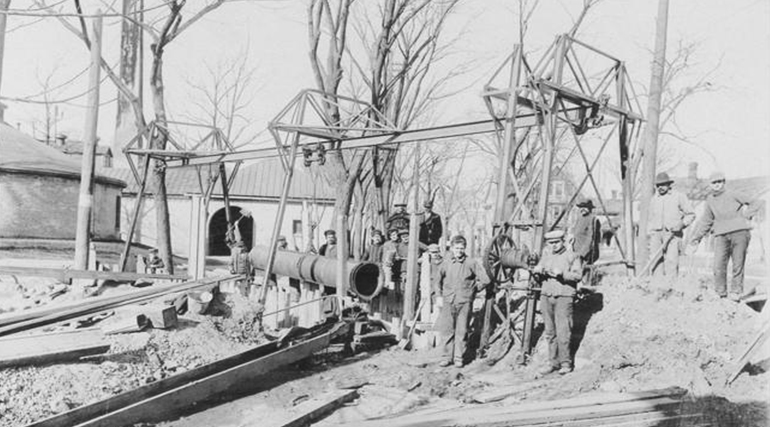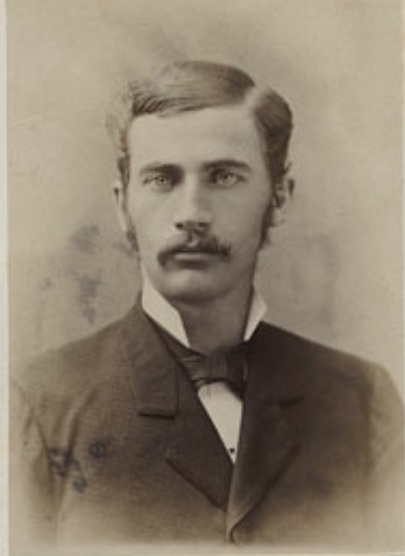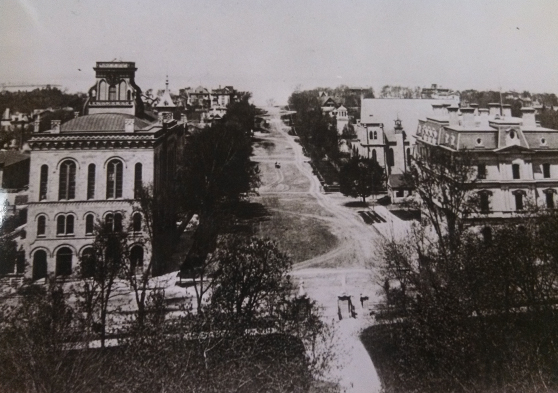Madison Water Utility turns 135!
posted
-- How a UW undergrad & a local bookbinder paved the way for safe water in Madison --

"People were getting sick"
Almost as soon as Madison was founded in 1848, there was talk of the need for a centralized water system to deal with fires that plagued the city. But by 1880, that talk had turned into a public outcry, largely because of a forward-thinking UW undergrad and his unusual chemistry experiments. His name was Magnus Swenson.
"The history of the water utility starts with this extraordinary individual," says historian and author Stu Levitan. "Magnus Swenson came to the city government and said, ‘You’ve got a serious problem here. You’ve got polluted, dangerous water. You need to do something about it."
Madisonians usually got their drinking water from hand-dug backyard wells and thought little of it, until Swenson started knocking on their doors and running “purity” tests on their water for his senior thesis.
"People had backyard wells and they had backyard cesspools, often only a few feet apart. And people figured, ‘Well, the couple feet between the cesspool and the water well, the natural filtration system of the ground, it will get rid of all the bad things. Obviously that wasn’t the case, and that’s why people were getting sick," Levitan explains.
 At the time, Swenson’s tests were revolutionary. Experiments in Europe connecting diseases like cholera and typhoid to drinking water were far from common knowledge in Madison, and "water purity" tests were unheard of.
At the time, Swenson’s tests were revolutionary. Experiments in Europe connecting diseases like cholera and typhoid to drinking water were far from common knowledge in Madison, and "water purity" tests were unheard of."Magnus Swenson was ahead of his time," says UW microbiology professor Dr. Sharon Long." "The information about organic matter and ammonia from wastewater as an indicator of risk was considered a radical concept."
She describes the type of test Swenson conducted on people's drinking water.
"He would have taken a solution of potassium permanganate and put two drops in the sample. And then (he) would wait overnight to see if the color faded, turned yellow or became clear. If it faded just to the pale pink, the water was considered safe, If it reacted to the organic matter just until it turned yellow, that would indicate that the water had organic matter at a level that was unsafe to drink. And then if it turned clear, it would really have a high level of organic matter. It’s still a good test!"
It may have been a good test, but results didn't sit well with many prominent members of the community. Swenson made headlines when he declared that 96 percent of the city’s well water was unfit to drink.
"People didn’t want to hear that their water was dirty. He had so many bricks and rocks thrown at him and dogs sicced on him, he needed a police escort," says Levitan
It may have been hard for some citizens to accept, but the press latched on, and eventually the public was swayed. Madison would create a city-wide waterworks.
"I think then as today having the University in Madison, you’ve got folks on the cutting edge of science keeping up on what’s going on around the globe as Magnus Swenson did," says Long.

Turning away from the lakes
In a city surrounded by lakes, the source to supply this new city water system may have seemed obvious.
"For any city on a large body of water in those days it was common practice to use the lake water or river water," explains hydrogeologist and author Ed Morse. "You just put a pipe in the lake and start pumping."
For Madison, Lake Monona seemed like an obvious water source. But there was a problem.
"The lake was polluted and everybody in Madison knew that," Morse says. No city sewer and no garbage pick up meant that trash and the contents of chamber pots were dumped in the streets. And that's not all.
"There were the animals. Madison probably had about 1,000 horses. Many families kept livestock—cows, pigs, chickens—and the cows would wander around the city during the day looking for grazing. Each of these animals left little deposits every day on the surface usually in the street. It probably amounted to about 10 tons of manure everyday. Consider that Madison drains either north to Lake Mendota or south to Lake Monona. After a heavy rain, a lot of this stuff on the surface would be washed into the lakes."
One of the worst pollution problems came from Madison’s most well-to-do neighborhoods.
"The wealthier families in town started installing water closets in their house. When you flush the toilet, that stuff goes down the drain and it has to go somewhere," explains Morse. "The homeowner would also build a sewer (line) from his house down to the lake. Now you’re getting untreated raw sanitary wastewater going straight into the lake, and long before you got to the lake you could smell it."
But Morse says unlike many cities, Madison had another option for its drinking water.
“Under the city there was a deep, productive sandstone aquifer. And not only that, it was an artesian aquifer, which meant that in many parts of the city you could drill a well down into the sandstone and the water would rise to the surface and flow naturally from the artesian pressure.”
So it was decided the city would dig deep wells, and the underground aquifer would become its water source. The next step would be for the city to install miles of water main and connect homes and businesses across Madison to the new water system. That is, unless it hired someone else to do it.
 (Photo: Water Utility superintendent John Heim oversees installation of new water main, cir. 1890.)
(Photo: Water Utility superintendent John Heim oversees installation of new water main, cir. 1890.) Push for privatization
"Once the city decided it needed a central water system, that’s when big business got interested," Levitan says. "And a Milwaukee firm started sniffing around for the contract. The Milwaukee company had offered to install the water system for free, all it wanted was a 25 year exclusive franchise."
Standing in the way was a local bookbinder and new Common Council member named John Heim.
"John Heim, at his very first Common Council meeting in May of 1881 thought, ‘You know, a water system is too important to give to a private company.' John Heim got a coalition on the Common Council to block it, and in August of 1881, the Council unanimously voted that something as important as a public water system had to be owned and operated by the City of Madison. It was a very strong statement that without John Heim probably wouldn’t have happened."
So the city turned to that bookbinder to lead the creation of its new water works. He would serve for 28 of the next 29 years as superintendent
"Madison became a model of municipal ownership for water utilities," Levitan says.
The Water Works of the City of Madison would eventually become Madison Water Utility, operating 22 water well facilities, maintaining more than 850 miles of water main, and bringing safe, reliable water to more than 245,000 people across the city.
"I don’t think people need to say a little hosanna to Magnus and John every time they step in their water closet," Levitan says. "But it would be nice if they appreciate the fact that it was individuals in the 1880s who established a paradigm that we live with today to our great success."
This content is free for use with credit to the City of Madison - Madison Water Utility and a link back to the original post.
Category: History
